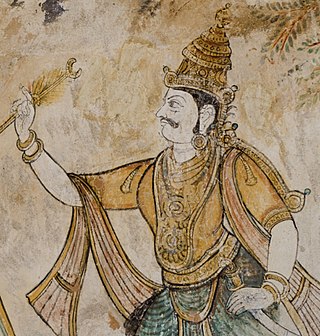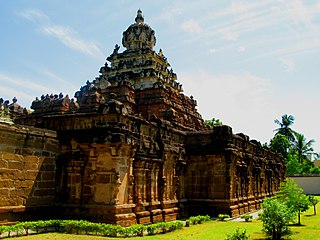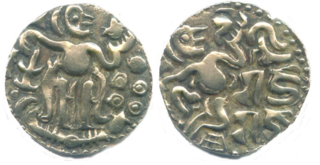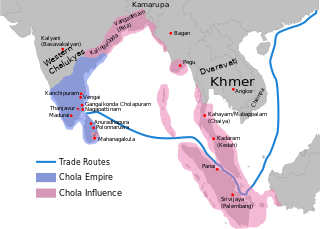
The Cholas, the Tamil kings of the Chola dynasty who had ruled most parts of South India, maintained a strong relationship with the Chinese.

The Cholas, the Tamil kings of the Chola dynasty who had ruled most parts of South India, maintained a strong relationship with the Chinese.
The relationship between the Chinese and Cholas dates back to second century BC. Ancient Chinese scholar Ban Gu had told that China had sent its ambassador to the court of the Cholas. [1] Ban Gu in his work the Book of Han (Ch'ien Han Shu) had written that he had seen many unprecedented objects which are unseen at China, at the city of kuvangtche. Berend, an acoustics expert, annotates that the city named by Ban Gu is analogous with the ancient Chola city kanchi (the present day's city of Kancheepuram at Tamil Nadu, India). This proves the relationship of Kanchi with China. [2]
Arrays of ancient Chinese coins have been found in recent years at the place which is considered to be the homeland of the Cholas (i.e. the present Thanjavur, Tiruvarur and Pudukkottai districts of Tamil Nadu, India), which confirms the trade and the commercial relationship which existed between the Cholas and the Chinese. [3]
| Place | Number of coins | Other details |
|---|---|---|
| Olayakkunnam | 323 | These coins are from 142-126 BC. This village is situated in Pattukkottai taluk in Pudukkottai district of Tamil Nadu, India |
| Thaalikkottai | 1822 | This village is situated in Mannargudi taluk in Tiruvarur district of Tamil Nadu, India |
The later Cholas too continued to maintain a healthy relationship with the Chinese. During the reign of Rajendra Chola I (i.e. 1016–1033 AD) and Kulothunga Chola I (i.e. in 1077 AD), commercial and political diplomats were sent to China. [4] [5]

The Pandyan dynasty, also referred to as the Pandyas of Madurai, was an ancient Tamil dynasty of South India, and among the four great kingdoms of Tamilakam, the other three being the Pallavas, the Cholas and the Cheras. Existing since at least the 4th to 3rd centuries BCE, the dynasty passed through two periods of imperial dominance, the 6th to 10th centuries CE, and under the 'Later Pandyas'. Under Jatavarman Sundara Pandyan I and Maravarman Kulasekara Pandyan I, the Pandyas ruled extensive territories including regions of present-day South India and northern Sri Lanka through vassal states subject to Madurai.

The Pallava dynasty existed from 275 CE to 897 CE, ruling a significant portion of the Deccan, also known as Tondaimandalam. The Pallavas played a crucial role in shaping the South Indian history and heritage during their rule. The dynasty rose to prominence after the downfall of the Satavahana dynasty, with whom they had formerly served as feudatories.

Rajaraja I, often described as Rajaraja the Great was a Tamil Chola emperor who reigned from 985 CE to 1014 CE. An iconic figure and often regarded as the 'King of Kings', he was the most powerful emperor in India during his reign and is remembered for reinstating the Chola influence and ensuring its supremacy across the Indian Ocean.

Kulottunga Chola I also spelt Kulothunga, born Rajendra Chalukya, was a Chola Emperor who reigned from 1070 CE to 1122 CE succeeding his cousin Athirajendra Chola. He also served as the Eastern Chalukya king from 1061 CE to 1118 CE, succeeding his father Rajaraja Narendra. He is related to the Chola dynasty through his mother's side and the Eastern Chalukyas through his father's side. His mother, Ammangaidevi, was a Chola princess and the daughter of emperor Rajendra Chola I. His father was king Rajaraja Narendra of the Eastern Chalukya dynasty who was the nephew of Rajendra Chola I and maternal grandson of Rajaraja Chola I. According to historian Sailendra Nath Sen, his accession marked the beginning of a new era and ushered in a period of internal peace and benevolent administration.
Rajendra I, who is often referred to as Rajendra the Great and Gangaikonda Cholan, and Kadaram Kondan, was a Chola Emperor who reigned from 1014 and 1044 CE. He was born in Thanjavur to Rajaraja I and his queen Vanathi and assumed royal power as co-regent with his father in 1012 until his father died in 1014, when Rajendra ascended to the Chola throne. During his reign, the Chola Empire reached its zenith in the Indian subcontinent; it extended its reach via trade and conquest across the Indian Ocean, making Rajendra one of only a few Indian monarchs who conquered territory beyond South Asia.

Kanchipuram also known as Conjeevaram, is a city in the Indian state of Tamil Nadu in the Tondaimandalam region, 72 km (45 mi) from Chennai – the capital of Tamil Nadu. Known as the City of Thousand Temples, Kanchipuram is known for its temple architectures, 1000-pillared halls, huge temple towers and silk saris. Kanchipuram serves as one of the most important tourist destinations in India. Kanchipuram has become a centre of attraction for foreign tourists as well. The city covers an area of 36.14 km2 (13.95 sq mi) and an estimated population of more than 300,000 in 2021. It is the administrative headquarters of Kanchipuram District. Kanchipuram is well-connected by road and rail.

Rajadhiraja I was a Chola emperor, the most skilled military commander among the Chola rulers and the successor of his father, Rajendra I. He was the only Chola emperor who was killed while leading his army in war, and although he had a short reign, he helped his father conquer several territories as well as to maintain the Chola authority over most of Sri Lanka, Eastern Chalukya and Kalinga, among others. He also established imperial relations with overseas allies despite a series of revolts in the territory.

The Chera dynasty, was a Sangam age dynasty who unified various regions of the western coast and western ghats in southern India to form the early Chera empire.

The Chola dynasty was a Tamil dynasty in southern India. At its height, it ruled over an expansive maritime empire known as the Chola empire. The earliest datable references to the Chola are from inscriptions dated to the 3rd century BCE during the reign of Ashoka of the Maurya empire. The Chola empire was at its peak and achieved imperialism under the Medieval Cholas in the mid-9th century CE. As one of the Three Crowned Kings of Tamilakam, along with the Chera and Pandya, the dynasty continued to govern over varying territories until the 13th century CE.

Tamilakam is the geographical region inhabited by the ancient Tamil people, covering the southernmost region of the Indian subcontinent. Tamilakam covered today's Tamil Nadu, Kerala, Puducherry, Lakshadweep and southern parts of Andhra Pradesh and Karnataka. Traditional accounts and the Tolkāppiyam referred to these territories as a single cultural area, where Tamil was the natural language and permeated the culture of all its inhabitants. The ancient Tamil country was divided into kingdoms. The best known among them were the Cheras, Cholas, Pandyans and Pallavas. During the Sangam period, Tamil culture began to spread outside Tamilakam. Ancient Tamil settlements were also established in Sri Lanka and the Maldives (Giravarus).

The Chola Empire, often referred to as the Imperial Cholas, was a Medieval Empire established by a branch of the Chola dynasty that rose to prominence during the middle of the 9th century CE and successfully united southern India under their rule.

Rajendra Chola III came to the Chola throne in 1246 CE. Rajendra began to take effective control over the administration, and epigraphs of Rajendra Chola III indicate there was civil war ending with the death of Rajaraja Chola III. Rajendra's inscriptions laud him as the "cunning hero, who killed Rajaraja after making him wear the double crown for three years".
A number of medieval inscriptions written in Tamil language and script that have been found in Southeast Asia and China, mainly in Sumatra and peninsular Thailand. These texts arose directly from trade links between south India and certain parts of Southeast Asia and China, which involved the residence in those regions of Tamil-speaking Indians. Several of these overseas Tamil inscriptions mention well-known medieval Indian merchant associations.

The Tondaiman family were Tamil rulers of the ancient Tondai Nadu (Tondaimandalam) division of Tamilakkam in South India. Their capital was at Kanchipuram.

Karunakara Tondaiman was a general of Chola Emperor Kulottunga I. He is renowned for leading the Chola invasion of Kalinga during the reign of Kulottunga I and is the hero of Jayamkondar's poem Kalinkkattuparani In the Parani poem he is referred to as the lord of Vandai. while in the Draksharamam inscription of Kulottunga I, he is called as Vanduvaraja and Pallavaraja. He also served as a minister under Kulothunga Chola's son and successor, Vikrama Chola.

Inscriptions and historical sources assert that the Medieval Chola Emperor Rajendra Chola I sent a naval expedition to Indochina, the Indonesia and Malay Peninsula in 1025 in order to subdue Srivijaya. The Thiruvalangadu plates, the Leyden grant, and the Tamil stele of Rajendra Chola I are the principal sources of information about the campaign.

The Three Crowned rulers, or the Three Glorified by Heaven, or World of the Three or The Tamil Kings, primarily known as Muvendar, refers to the triumvirate of Chera, Chola and Pandya who dominated the politics of the ancient Tamil country, Tamilakam, from their three Nadu (countries) of Chola Nadu, Pandya Nadu and Chera Nadu in southern India. They signalled a time of integration and political identity for the Tamil people. They frequently waged war against one another under a period of instability and between each other, held control over Greater Tamilakam from 6th century BCE to the 13th century. After being defeated by the Pandyas, the Cholas fled to Devicottah and are later mentioned in various texts that participated in wars in the 16th century.

Tamils maintained a good relationship with the Chinese, with evidence of trade relations going back to 2nd century BC.

In 1025 CE, the Chola Emperor Rajendra I launched naval raids on Srivijaya in maritime Southeast Asia, Rajendra's overseas expedition against Srivijaya was a unique event in India's history and its otherwise peaceful relations with the states of Southeast Asia. Several places in present-day Indonesia and Malay Peninsula were invaded by Rajendra I of the Chola dynasty. The Chola invasion furthered the expansion of Tamil merchant associations such as the Manigramam, Ayyavole and Ainnurruvar into Southeast Asia. The Cholan invasion led to the fall of the Sailendra Dynasty of Srivijaya and the Chola invasion also coincides with return voyage of the great Buddhist scholar Atiśa from Sumatra to India and Tibet in 1025 CE.

Tamil dynasties are the kingdoms who ruled over present day Tamil Nadu, Sri Lanka, Andhra Pradesh, Karnataka, Kerala and Odisha. These include the Pallavas, the Pandyas, the Cholas and the Cheras.